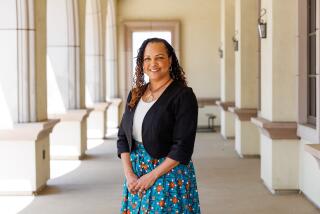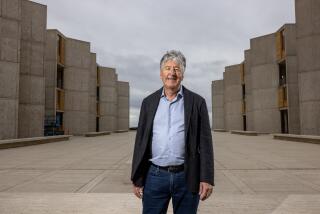Prestigious Brain Research Group to Relocate in S.D. : Science: Move to Scripps Research Institute reflects city’s growing importance in scientific circles.
- Share via
SAN DIEGO — In a move that signals San Diego’s maturation as a heavyweight in scientific circles, a prestigious New York City brain research center announced Friday that it will relocate here.
The Neurosciences Institute, an independent center based at Rockefeller University, will move to the Scripps Research Institute, where a building will be constructed to house the team.
Dr. Gerald Edelman, director of NSI, won the Nobel Prize in 1972 for his research on the chemical structure of antibody molecules. Edelman has also put forth a controversial theory on brain function, dubbed “neural Darwinism,” which applies to the human brain the Darwinian theory that evolution is the survival of the fittest.
At NSI, five research fellows and 17 scientists work to better understand cognition and how the brain works. Such work could lead to better diagnostic tools and therapies to combat brain diseases, said Einar Gall, NSI’s research director. It also could lead to artificial human-like brains, said Gall, who explained that Edelman and his team scoff at the term “artificial intelligence,” because they believe, in its current form, artificial intelligence is not intelligent.
“The vast technical advances and experimental discoveries of the past two decades have created a unique opportunity for major progress in understanding the brain. But theories to integrate this information are needed,” Edelman said.
At NSI, the goal is to develop biologically based theories of the brain because these “are more likely to explain brain functions than are theories derived from non-biological fields, such as computer sciences, neural nets or artificial intelligence,” Edelman said.
The institute has a $2-million annual budget, less than 15% of which comes from government grants, officials said. The rest comes from foundations and private grants, they said. With the move to La Jolla, the researchers will more than double the space of their existing quarters in Manhattan.
Scripps will construct a 20,000-square-foot “small but elegant” building for the institute just east of the molecular biology building on North Torrey Pines Road, said Dr. William Beers, Scripps’ senior vice president. Scripps officials are now selecting an architect for the building, which is to be completed by 1994 on the southern end of the 20-acre campus.
Half of the space will be devoted to offices, computer rooms, a conference room and a library. The other 10,000 square feet will be used for laboratory space, facilities that the institute now lacks at Rockefeller, where its 12-year contract expires in June, 1994.
At Scripps, the institute will remain completely independent--as it has at Rockefeller. But, because the institute offers international fellowships and study stints, local researchers believe the institute will increase opportunities for scientific exchanges and discussions. Since it was founded in 1982, more than 850 scientists from 24 countries have participated in NSI’s programs.
Several East Coast universities, such as Princeton, had wooed NSI officials in hopes of luring the brain think tank to their campuses. Before its location at Rockefeller, NSI was housed at the Massachusetts Institute of Technology. At Scripps, winning the institute is regarded as a major coup.
“We’re honored,” said Dr. Charles C. Edwards, president and chief executive officer of the Scripps Institutions of Medicine and Science, the parent organization. “Not only will this move complement and broaden our scientific investigations, it represents a major acquisition for the West Coast.”
As others point out, the move also reflects San Diego’ growing importance in scientific circles.
“We think it’s very significant. People would have bet that this institute would never have left the East Coast established institutions--that’s been a major perception about where science is at in the U.S.,” Beers said. “Ten years ago, if you proposed this possibility, people would have laughed at you.”
Edelman has also been chairman of Scripps’ board of scientific governors, an outside group of 12 scientists that regularly visits and evaluates the institute. Since he has been on the board for five years, he has become increasingly familiar and enthusiastic about the research conducted at Scripps, Beers said.
The reason for the move was not financial because NSI is paying fair market rent, he said. Edelman chose Scripps because it’s viewed as “an important place to be--there’s a tilt now to the West Coast,” Beers said.
Edelman will join the Scripps faculty this summer to head the newly created Department of Neurobiology, which is independent of NSI. At that time, he will resign his position with the Scripps board.
In the scientific world, Edelman is well-known for his theory on neural Darwinism, or “neuronal group selection,” the subject of a book he wrote. According to this theory, a person’s experiences shape and alter his brain in unique ways. These alterations affect how an individual responds to future experiences.
Currently at NSI, scientists use supercomputers to create simulations of intelligent robots. These are programmed to learn from experience to categorize objects, respond to their environment and even react in unpredictable ways.
NSI researchers hope to unlock the secrets of the brain, which has 50 billion cells and millions of connections among them. And the fields of study will be wide-ranging, Gall said.
“We are working at several different levels on the brain,” Gall said.
Some scientists, for instance, are examining what--if any--role nitric oxide plays in changes in memory. Still others are examining the way the brain develops.
“With an institution like that,” said Beers of Scripps, “it’s hard to predict what’s going to happen.”






